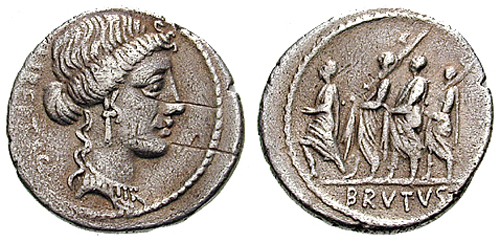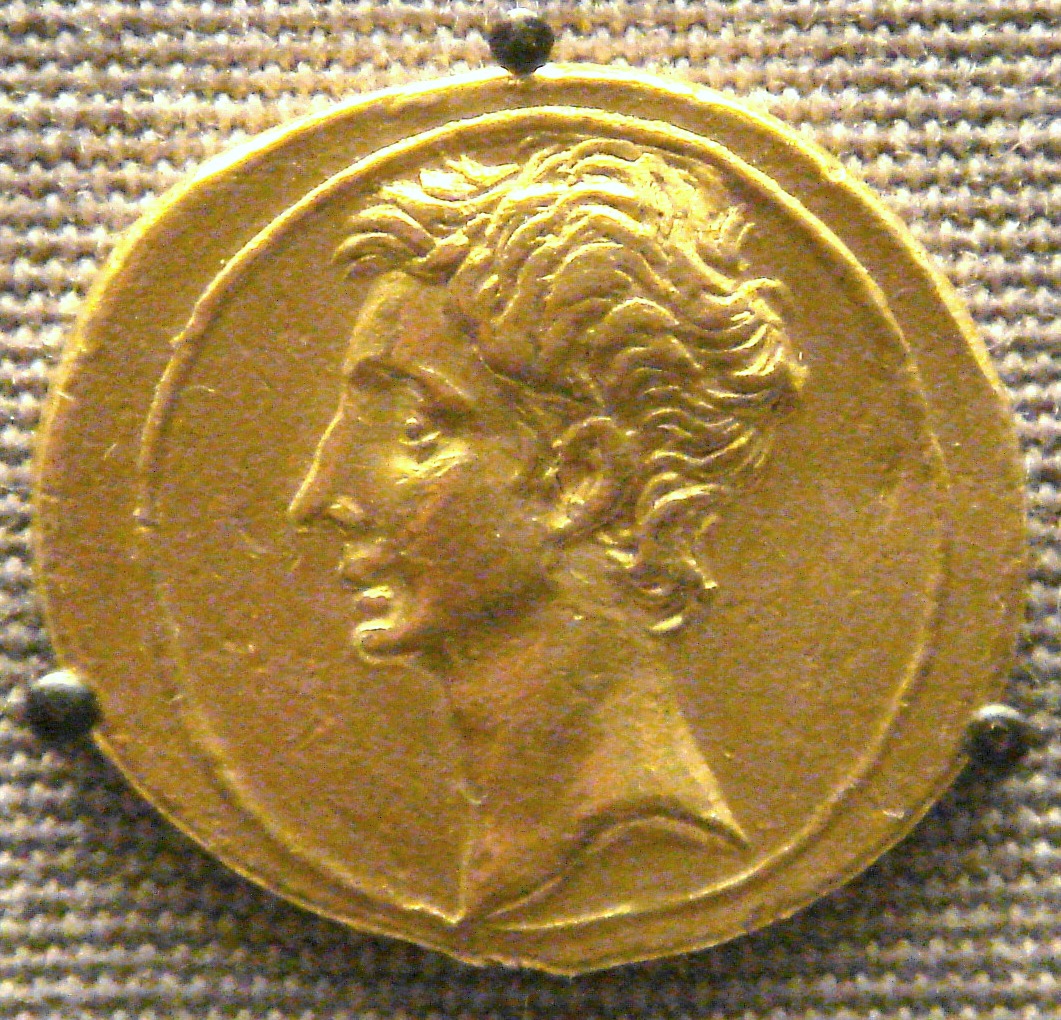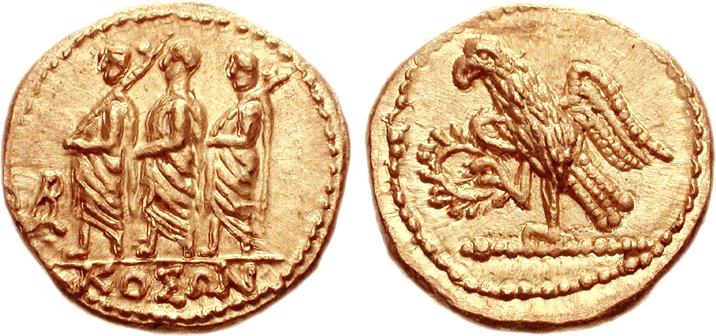|
Coson
The Kosons are the only gold coins that have been minted by the Dacians, named after the Greek alphabet inscription "ΚΟΣΩΝ" on them.Bogdan Constantinescu et al.,Archaeometallurgical Characterization Of Ancient Gold Artifacts From Romanian Museums Using XRF, Micro-pixe And Micro-SR-XRF Methods, in ''Proceedings Of The Romanian Academy'' Series A, Volume 13, Number 1/2012, pp. 19–26 It is thought that "Koson" is the name of an otherwise historically unrecorded Dacian king, though he may be identical to the Cotison mentioned by Horace and Suetonius. Description The coins contain Roman iconography: on the obverse, there is an eagle standing on a scepter and holding a wreath in their claw (inspired by the silver denarii issued by Pomponius Rufus); the reverse contains three men dressed in togas, two of them holding an axe on the shoulder (possibly inspired by the silver denarii issued by Marcus Junius Brutus in 54 BC). Discovery Coins inscribed KOSON were discovered in sever ... [...More Info...] [...Related Items...] OR: [Wikipedia] [Google] [Baidu] |
Aureus D'or Représentant Un Consul Entre Deux Licteurs
The ''aureus'' ( ''aurei'', 'golden') was the main gold coin of ancient Rome from the 1st century BC to the early 4th century AD, when it was replaced by the ''solidus''. This type of coin was sporadically issued during the Republic and standardized during the Empire, originally valued at 25 silver ''denarii'' and 100 ''sestertii''. It was about the same size as the ''denarius'', but heavier than the ''denarius'' since gold is denser than silver. During the Republic The production of proper Roman coins began in the 3rd century BC and was limited to the minting of bronze ''asses''; the gold brought back from spoils and war indemnities was stored in the public treasury (''Aerarium''). According to the needs of the state finances, the gold in the reserve was sold for minted silver, at a ratio of 1 to 12. The Second Punic War (218–201), due to its considerable financing needs, made it necessary to draw on the reserves of precious metal. Rome therefore issued silver ''denarii'' a ... [...More Info...] [...Related Items...] OR: [Wikipedia] [Google] [Baidu] |
Dio Cassius
Lucius Cassius Dio (), also known as Dio Cassius ( ), was a Roman historian and senator of maternal Greek origin. He published 80 volumes of the history of ancient Rome, beginning with the arrival of Aeneas in Italy. The volumes documented the subsequent founding of Rome (753 BC), the formation of the Republic (509 BC), and the creation of the Empire (27 BC) up until 229 AD, during the reign of Severus Alexander. Written in Koine Greek over 22 years, Dio's work covers approximately 1,000 years of history. Many of his books have survived intact, alongside summaries edited by later authors such as Xiphilinus, a Byzantine monk of the 11th century, and Zonaras, a Byzantine chronicler of the 12th century. Biography Lucius Cassius Dio was the son of Cassius Apronianus, a Roman senator and member of the Cassia gens, who was born and raised at Nicaea in Bithynia. Byzantine tradition maintains that Dio's mother was the daughter or sister of the Greek orator and philosopher, ... [...More Info...] [...Related Items...] OR: [Wikipedia] [Google] [Baidu] |
Cotiso
Cotiso, Cotish or Cotison (flourished c. 30 BC) was a Dacian or Getic king who apparently ruled the mountains between Banat and Oltenia (modern-day Romania). Horace and Florus call him a Dacian; Suetonius calls him king of the Getae. Florus wrote in his account of Roman history that Cotiso and his armies used to attack towards south when the Danube froze. Some scholars believe he is identical to Coson, a Dacian king whose name appears on gold staters found in Transylvania. Background After the death of Burebista, the Dacian kingdom fell apart amid turmoil and civil strife. Cotiso appears to have emerged as the dominant figure in Dacia at this time, but nothing is known about his background. The new king found himself courted by the two Roman antagonists, Octavian and Mark Antony. Cotiso was in a strong position to dictate terms of any alliance to either of the conflicting parties. Octavian/Augustus worried about the frontier and possible alliance between Mark Antony and the Dac ... [...More Info...] [...Related Items...] OR: [Wikipedia] [Google] [Baidu] |
Brutus
Marcus Junius Brutus (; ; 85 BC – 23 October 42 BC) was a Roman politician, orator, and the most famous of the assassins of Julius Caesar. After being adopted by a relative, he used the name Quintus Servilius Caepio Brutus, which was retained as his legal name. He is often referred to simply as Brutus. Early in his political career, Brutus opposed Pompey, who was responsible for Brutus' father's death. He also was close to Caesar. However, Caesar's attempts to evade accountability in the law courts put him at greater odds with his opponents in the Roman elite and the senate. Brutus eventually came to oppose Caesar and sided with Pompey against Caesar's forces during the ensuing civil war (49–45 BC). Pompey was defeated at the Battle of Pharsalus in 48, after which Brutus surrendered to Caesar, who granted him amnesty. With Caesar's increasingly monarchical and autocratic behaviour after the civil war, several senators who later called themselves ''liberatores'' (liber ... [...More Info...] [...Related Items...] OR: [Wikipedia] [Google] [Baidu] |
Theodor Mommsen
Christian Matthias Theodor Mommsen (; ; 30 November 1817 – 1 November 1903) was a German classical scholar, historian, jurist, journalist, politician and archaeologist. He is widely regarded as one of the greatest classicists of the 19th century. He received the 1902 Nobel Prize in Literature for his historical writings, including '' The History of Rome'', after having been nominated by 18 members of the Prussian Academy of Sciences. He was also a prominent German politician, as a member of the Prussian and German parliaments. His works on Roman law and on the law of obligations had a significant impact on the German civil code. Life Mommsen was born to German parents in Garding in the Duchy of Schleswig in 1817, then ruled by the king of Denmark, and grew up in Bad Oldesloe in Holstein, where his father was a Lutheran minister. He studied mostly at home, though he attended the Gymnasium Christianeum in Altona for four years. He studied Greek and Latin and receive ... [...More Info...] [...Related Items...] OR: [Wikipedia] [Google] [Baidu] |
Vasile Pârvan
Vasile Pârvan (; 28 September 1882 – 26 June 1927) was a Romanian historian and archaeologist. Biography Pârvan was born in Perchiu, Huruiești commune, Bacău County. He came from a modest family, being the first child of the teacher Andrei Pârvan (with ancestors from Bessarabia) and of Aristița Chiriac (from Dobrenii Neamțului). He received the first name Vasile, as well as his uncle, Vasile Conta (his mother being the philosopher's cousin). In 1913 Pârvan married Silvia Cristescu, niece of Ioan Bogdan, his former teacher. During World War I, he took refuge in Iași (in 1916) and then in Odessa (in 1917), where his wife died in childbirth. Passionate about the work on site, Pârvan ignored the appendicitis he suffered from. He finally arrived on the operating table, but it was too late to save his life; he died in Bucharest at age 45, in full creative power. Education He attended primary education in Berești and high school studies at the Gheorghe Roșca Co ... [...More Info...] [...Related Items...] OR: [Wikipedia] [Google] [Baidu] |
Rotterdam
Rotterdam ( , ; ; ) is the second-largest List of cities in the Netherlands by province, city in the Netherlands after the national capital of Amsterdam. It is in the Provinces of the Netherlands, province of South Holland, part of the North Sea mouth of the Rhine–Meuse–Scheldt delta, via the Nieuwe Maas, New Meuse inland shipping channel, dug to connect to the Meuse at first and now to the Rhine. Rotterdam's history goes back to 1270, when a dam was constructed in the Rotte (river), Rotte. In 1340, Rotterdam was granted city rights by William II, Count of Hainaut, William IV, Count of Holland. The Rotterdam–The Hague metropolitan area, with a population of approximately 2.7 million, is the List of urban areas in the European Union, 10th-largest in the European Union and the most populous in the country. A major logistic and economic centre, Rotterdam is Port of Rotterdam, Europe's largest seaport. In 2022, Rotterdam had a population of 655,468 and is home to over 1 ... [...More Info...] [...Related Items...] OR: [Wikipedia] [Google] [Baidu] |
Erasmus
Desiderius Erasmus Roterodamus ( ; ; 28 October c. 1466 – 12 July 1536), commonly known in English as Erasmus of Rotterdam or simply Erasmus, was a Dutch Christian humanist, Catholic priest and Catholic theology, theologian, educationalist, Menippean satire, satirist, and philosopher. Through his Works of Erasmus, works, he is considered one of the most influential thinkers of the Northern Renaissance and one of the major figures of Dutch and Western culture. Erasmus was an important figure in classical scholarship who wrote in a spontaneous, copious and natural Latin style. As a Catholic priest developing Philology, humanist techniques for working on texts, he prepared pioneering new Vulgate, Latin and Biblical Greek, Greek scholarly editions of the Novum Instrumentum omne, New Testament and of the Church Fathers, with annotations and commentary that were immediately and vitally influential in both the Protestant Reformation and the Catholic Reformation. He also wrote ''De ... [...More Info...] [...Related Items...] OR: [Wikipedia] [Google] [Baidu] |
Sarmizegetusa Regia
Sarmizegetusa Regia (also known as ''Sarmisegetusa'', ''Sarmisegethusa'', ''Sarmisegethuza''; ) was the capital and the most important military, religious and political centre of the Dacians before the wars with the Roman Empire. Built on top of a 1200 m high mountain, the fortress, consisting of six citadels, was the core of a strategic and defensive system in the Orăștie Mountains (in present-day Romania). Sarmizegetusa Regia should not be confused with Ulpia Traiana Sarmizegetusa, the Roman capital of Dacia built by Roman Emperor Trajan some 40 km away, which was not the Dacian capital. Sarmizegetusa Ulpia was discovered earlier, was known already in the early 1900s, and was initially mistaken for the Dacian capital, a confusion which led to incorrect conclusions being made regarding the military history and organization of the Dacians. Etymology Several hypotheses have been advanced to explain the origin of the name ''Sarmizegetusa''. The most important of these ... [...More Info...] [...Related Items...] OR: [Wikipedia] [Google] [Baidu] |
Orăștie
Orăștie (; , , , '' Transylvanian Saxon'': Brooss) is a small town and municipality in Hunedoara County, south-western Transylvania, central Romania. History 7th–9th century – On the site of an old swamp was a human settlement, now the location of the old town center, whose remains can be traced into the 10th century when the first fortification was built with raised earth and wood stockades. 11th–12th century – The first Christian religious edifice was raised: The Orăștie Rotunda. It is a circular chapel, with an age estimated at 1000 years. Perhaps it was used only by aristocratic families that dominated the Orăștie area and surroundings in the 11th century. Nearby there is a similar construction from the same period – The Geoagiu Rotunda. 1105 – In the wake of the First Crusade Anselm von Braz ”liber de liberis genitus", châtelain of Logne, Walloon ministerial count settled here. The historian Karl Kurt Klein implies – ... [...More Info...] [...Related Items...] OR: [Wikipedia] [Google] [Baidu] |
Dacian Fortresses Of The Orăştie Mountains
Dacian may refer to: Relating to "Dacia" * of or relating to Dacia in southeastern Europe ** Dacians, the ancient Indo-European inhabitants of the cultural region of Dacia ** Dacian language * of or relating to one of the other meanings of Dacia Given name * Dacian or Dacianus, 4th-century Roman prefect who persecuted Christians * Dacian Cioloș (born 1969), Romanian agronomist, politician and former prime minister * Dacian Varga Dacian Şerban Varga (born 15 October 1984) is a Romanian former professional footballer who played as a winger. Career Childhood Varga began his football career at the age of 8, when his father took him at an indoor-football club based in ... (born 1984), Romanian footballer See also {{Disambiguation, given name Language and nationality disambiguation pages Romanian masculine given names Masculine given names ... [...More Info...] [...Related Items...] OR: [Wikipedia] [Google] [Baidu] |





